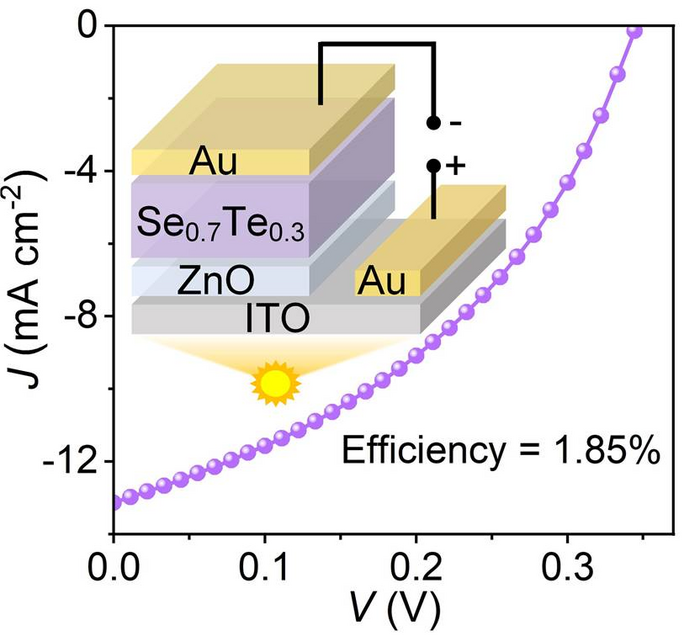With carbon dioxide emissions reaching a record high in 2021, clean energy is more crucial than ever. Solar energy is one such fossil-fuel alternative.
 A structural diagram of ZnO/Se0.7Te0.3solar cells charted to show the JV curve, or the current-voltage relationship shows that ZnO/Se0.7Te0.3 solar cells achieve a superior efficiency of 1.85%. Image Credit: Jiajia Zheng, Liuchong Fu, Yuming He, Kanghua Li, Yue Lu, Jiayou Xue, Yuxuan Liu, Chong Dong, Chao Chen, and Jiang Tang.
A structural diagram of ZnO/Se0.7Te0.3solar cells charted to show the JV curve, or the current-voltage relationship shows that ZnO/Se0.7Te0.3 solar cells achieve a superior efficiency of 1.85%. Image Credit: Jiajia Zheng, Liuchong Fu, Yuming He, Kanghua Li, Yue Lu, Jiayou Xue, Yuxuan Liu, Chong Dong, Chao Chen, and Jiang Tang.
Selenium (Se) is a preferable option, according to Chao Chen of the Wuhan National Laboratory for Optoelectronics (WNLO) and School of Optical Electronic Information at Huazhong University of Science and Technology in China, since it is inexpensive, stable, and nontoxic. However, its low melting point and huge bandgap, or the range in which no electronic states may exist, limit its efficacy. Now that Chen and other researchers have overcome these constraints by alloying selenium with tellurium (Te), selenium solar cells are a more tempting option.
The study was published in the Frontiers of Optoelectronics journal.
According to the scientists, the optimal bandgap range for single-junction solar cells is 1–1.5 eV. However, Se’s bandgap is roughly 1.8 eV, making it less than ideal for deployment in solar cells. By combining selenium and tellurium, the scientists were able to tailor the solar cells to the Shockley-Queisser limit, which is the maximum potential efficacy of a single-junction solar cell.
Alloying [selenium] with tellurium, which has the same crystal structure and [has a] narrow bandgap, can tune the bandgap and increase the melting point, thus expanding the absorption spectrum and improving the quality of [the selenium solar cell] films. Therefore Se1-xTex alloy is expected to achieve the improvement of solar cell efficiency.
Chao Chen, Study Corresponding Author and Associate Professor, School of Optical Electronic Information, Huazhong University of Science and Technology
Due to the perfect band alignment and moderate reaction at the interface of the zinc oxide and the selenium/tellurium, the investigators also employed zinc oxide (ZnO) as an electron transport layer in the manufacturing of the solar cells.
Zinc oxide was selected as the electron transport layer, which can slightly react with Se to enhance its interfacial adhesion and to reduce dangling bonds and thus reduce interfacial defects.
Chao Chen, Study Corresponding Author and Associate Professor, School of Optical Electronic Information, Huazhong University of Science and Technology
The use of zinc oxide, together with the scientists’ examination of particular parts of the selenium tellurium solar cells, was one of the innovative features of this study, according to Chen.
The recombination mechanism and defect type of Se1-xTex alloy solar cell were analyzed by characterizations of light intensity dependent current-voltage, capacitance-voltage and temperature dependent admittance, which will help to further optimize the Se1-xTex alloy system.
Chao Chen, Study Corresponding Author and Associate Professor, School of Optical Electronic Information, Huazhong University of Science and Technology
Investigators found that the new material keeps the previously recognized positive attributes of having a large absorption coefficient and being very photoconductive while boosting efficiency in the new selenium tellurium solar cells.
Chen says, “The efficiency of ZnO/Se0.7Te0.3 solar cells has more than doubled after nine months in the air. ZnO/Se0.7Te0.3 [is proven as] a superior junction with energy band matching and tight adhesion, and the efficiency of 1.85% has been achieved preliminarily.”
Scientists are currently striving to enhance the production of solar cells and eventually scale the technique.
Chen adds, “The next step will be to prepare high-quality Se1-xTex alloy films—eliminate holes and vacancy defects and so on—and optimize device structure—adding the hole transport layer and so on—so as to further improve the efficiency of Se1-xTex alloy solar cells and achieve mass production.”
Jiajia Zheng, Yue Lu, Jiayou Xue, and Jiang Tang, all of WNLO and School of Optical and Electronic Information and the China-EU Institute for Clean and Renewable Energy, all at Huazhong University of Science and Technology; Liuchong Fu, Yuming He, Kanghua Li, Yuxuan Liu, and Chong Dong, all of WNLO and School of Optical and Electronic Information at Huazhong University of Science and Technology took part in the study.
The study was funded by the National Natural Science Foundation of China, the Natural Science Foundation of Hubei Province, the Fundamental Research Funds for the Central Universities, the National Key R&D Program of China, and the China Postdoctoral Science Foundation.
Journal Reference:
Zheng, J., et al. (2022) Fabrication and characterization of ZnO/Se1-xTex solar cells. Frontiers of Optoelectronics. doi.org/10.1007/s12200-022-00040-5.